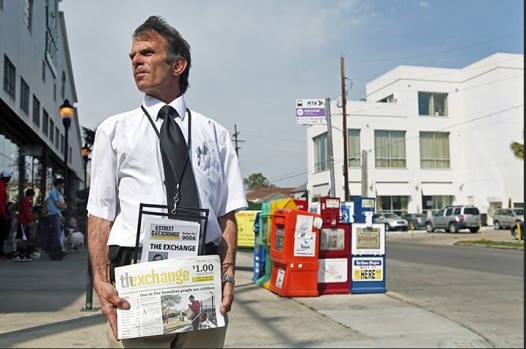
The Exchange, about issues of homelessness, is sold by vendors who are homeless themselves. (Photo by Betsy Charron)
In these newspaper-challenged times, it’s nice to see a new print publication hit the streets.
But The Exchange is not like most other papers you buy from a corner vendor. It’s about, and frequently by, the homeless population in New Orleans.
Street papers, in the modern era, started in 1989 with Street News in New York City. Since then, the movement has grown to include some 80 papers around the world, including the Street Sheet in San Francisco, StreetWise in Chicago and Spare Change in Boston. There’s a trade association, too, the North American Street Newspaper Association (NASNA).
The idea is to offer a source of income to the homeless or poor, while educating the population at large about homeless issues.
New Orleans, say Exchange founders Betsy Charron and Todd Thaxton, was a natural for a street paper.
“The focus is on people who fear becoming homeless,” explains Thaxton, a teacher, writer and editor who has a master’s in English from the University of New Orleans. “If you look at New Orleans artists, musicians and others like them, many are right on that poverty line. The face of homelessness is changing.”
Charron, who earned a master’s in public health from Tulane University, realized the potential of a street paper after attending a NASNA convention in Nashville.
“I saw what a difference it can make – one-third of Nashville vendors were getting off the streets,” she says.
Charron and Thaxton spent most of last year setting up The New Orleans Street Exchange, a non-profit housed in a donated upstairs loft at The New Orleans Mission. The organization oversees publication of the street paper, trains vendors to sell it, and runs a literacy program.
The first Exchange issue, devoted to stories about homeless youth, came out in February. The paper is published quarterly, although plans are to move to monthly editions as soon as possible.
Vendors come from the city’s homeless population. They must pass a training course and be licensed. They get 10 free copies of the paper, priced at $1 each, to sell; they can return for additional copies at 25 cents each.
“The paper changes the way you think of the homeless,” says Jessie Pullins, a local advocate for the homeless and a member of the New Orleans Street Exchange board. “It changes sellers’ lives, and it changes buyers’ lives. It makes a connection between people that you normally wouldn’t have. This paper will reach people who normally wouldn’t give me the time of day.
“Having my story told let’s people see me in a different light. There’s a thin line between those who are homeless and those who are not. Katrina showed us that.”
The first edition of The Exchange is filled with stories by volunteer contributors, including former Times-Picayune reporter Katy Reckdahl, New Orleans Mission Executive Director David Bottner and Tacara Solomon, a homeless teenager from the organization’s literacy program. Articles are available from NASNA and news services such as Reuters, but most of the content is specific to New Orleans. Only two stories in the first edition are not local, and one is a profile of a street paper vendor (in Brazil) – a regular feature that will focus on a local vendor beginning with the next issue.
“We have had a very, very good response,” Charron says. “From contributors, buyers, advertisers. And for the vendors, it can be very empowering to have $25 in your pocket from selling papers that wasn’t there that morning.”
The tabloid-sized, 20-page paper looks – and reads – like any other. There are features on music, interviews with interesting personalities, a spotlight piece on local hip hop artist Truth Universal. Comic strips, a full page of local resources and a crossword puzzle.
“That was important to me,” Charron says of the latter. “When I volunteered at the Ozanam Inn, I saw so many of the guys working crossword puzzles, I decided we had to have one.”
The one unifying theme, of course, is homelessness. In this instance, as it affects young people. The next issue, in May, will focus on homelessness in the context of food and health.
“The main thing is to try to challenge stereotypes,” Thaxton says. “To try to start a dialogue. We were both surprised by the (first issue’s) quality. You always have a vision, but to see it materialize, and in such a strong way … that’s a good surprise.”
For more information on the New Orleans Street Exchange and its programs, go to nolastreets.org. To sign up for The Exchange newsletter, click here. To subscribe to the newspaper, email bcharron@nolastreets.org.
These photographs by Betsy Charron were taken during street sales last weekend in New Orleans:
Renee Peck is editor of NolaVie.
 NOLAbeings Multimedia artist Claire Bangser created NOLAbeings as a portrait-based story project that marries...
NOLAbeings Multimedia artist Claire Bangser created NOLAbeings as a portrait-based story project that marries...  Voodoo in New Orleans: Reviving history: New Orleans fortune telling This article takes a deep dive into the history of Voodoo in New Orleans, its hybridization with Catholicism, and its present-day place in the city's culture. The author visits fortune-tellers in the French Quarter, using their guidance as a tool for introspection rather than a deterministic predictor of the future. Through her experiences in New Orleans, the author feels a mystical connection to both the past and the future.
Voodoo in New Orleans: Reviving history: New Orleans fortune telling This article takes a deep dive into the history of Voodoo in New Orleans, its hybridization with Catholicism, and its present-day place in the city's culture. The author visits fortune-tellers in the French Quarter, using their guidance as a tool for introspection rather than a deterministic predictor of the future. Through her experiences in New Orleans, the author feels a mystical connection to both the past and the future. 